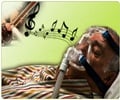People suffering from physical disabilities, such as cerebral palsy, may now experience the positive effects of music with the help of a computerised instrument that enables one to play music with the tip of their nose.
The interface may also be adapted for speech, giving physically challenged patients the ability to form full sentences, rather than just providing yes or no responses."This instrument will give a voice to those who are all too often ignored, due to their physical disability," said Zane Van Dusen, a recent graduate of computer science and electronic media arts and communications at Rensselaer Polytechnic Institute in Troy, NY.
Van Dusen developed the interface with Pauline Oliveros, a musician and distinguished professor of the arts at Rensselaer.
The new "adaptive-use musical instrument" can be operated merely with the help of an inexpensive Web camera and specialised computer software developed by Van Dusen.
"The cost of the hardware and software is not going to be expensive and that makes it accessible," Discovery quoted Leaf Miller, a professional musician and an occupational therapist at Rehab Programs in Poughkeepsie, NY, as saying.
Physically challenged patients are placed in front of the computer, where they see live video of their face through a Web camera. The motion-tracking software places a red box on the tip of the person's nose, and tracks the user's movement across an onscreen keyboard.
Advertisement
In "keyboard mode", the person stays within the rectangle, touching on keys to illicit notes. While in "percussive mode", he can move outside the rectangle to set off a snare drum or cymbal sound.
Advertisement
"The added benefit of all of this is that the children are working on their head control," said Leaf Miller, a professional musician and an occupational therapist at Rehab Programs in Poughkeepsie, NY.
"It can also be adapted for speech language pathologists to use for communication," she added.
The researchers will begin further study this summer to perfect the prototype, and create additional interfaces for an organisation that fosters a unique approach to music, literature, art and meditation. They hope that their system may offer a way for the physically challenged patients to express the song they have on the tip of their nose.
Source: ANI
LIN/M






